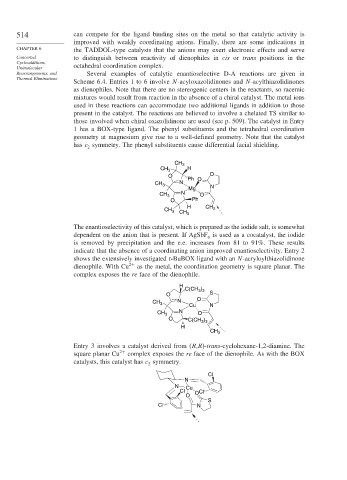Page 540 - Advanced Organic Chemistry Part B - Reactions & Synthesis
P. 540
514 can compete for the ligand binding sites on the metal so that catalytic activity is
improved with weakly coordinating anions. Finally, there are some indications in
CHAPTER 6 the TADDOL-type catalysts that the anions may exert electronic effects and serve
Concerted to distinguish between reactivity of dienophiles in cis or trans positions in the
Cycloadditions,
Unimolecular octahedral coordination complex.
Rearrangements, and Several examples of catalytic enantioselective D-A reactions are given in
Thermal Eliminations
Scheme 6.4. Entries 1 to 6 involve N-acyloxazolidinones and N-acylthiazolidinones
as dienophiles. Note that there are no stereogenic centers in the reactants, so racemic
mixtures would result from reaction in the absence of a chiral catalyst. The metal ions
used in these reactions can accommodate two additional ligands in addition to those
present in the catalyst. The reactions are believed to involve a chelated TS similar to
those involved when chiral oxazolidinone are used (see p. 509). The catalyst in Entry
1 has a BOX-type ligand. The phenyl substituents and the tetrahedral coordination
geometry at magnesium give rise to a well-defined geometry. Note that the catalyst
has c symmetry. The phenyl substituents cause differential facial shielding.
2
CH 3
CH 3 H
O Ph O O
CH 3 N
Mg N
CH 3 N O
O Ph
H CH
CH 2
3 CH 3
The enantioselectivity of this catalyst, which is prepared as the iodide salt, is somewhat
dependent on the anion that is present. If AgSbF is used as a cocatalyst, the iodide
6
is removed by precipitation and the e.e. increases from 81 to 91%. These results
indicate that the absence of a coordinating anion improved enantioselectivity. Entry 2
shows the extensively investigated t-BuBOX ligand with an N-acryloylthiazolidinone
dienophile. With Cu 2+ as the metal, the coordination geometry is square planar. The
complex exposes the re face of the dienophile.
H
C(CH 3 ) 3
O S
CH N O
3
Cu N
CH 3 N O
O C(CH )
3 3
H
CH 3
Entry 3 involves a catalyst derived from (R,R)-trans-cyclohexane-1,2-diamine. The
square planar Cu 2+ complex exposes the re face of the dienophile. As with the BOX
catalysts, this catalyst has c symmetry.
2
Cl
N
N Cu
Cl O Cl
O
S
Cl N

